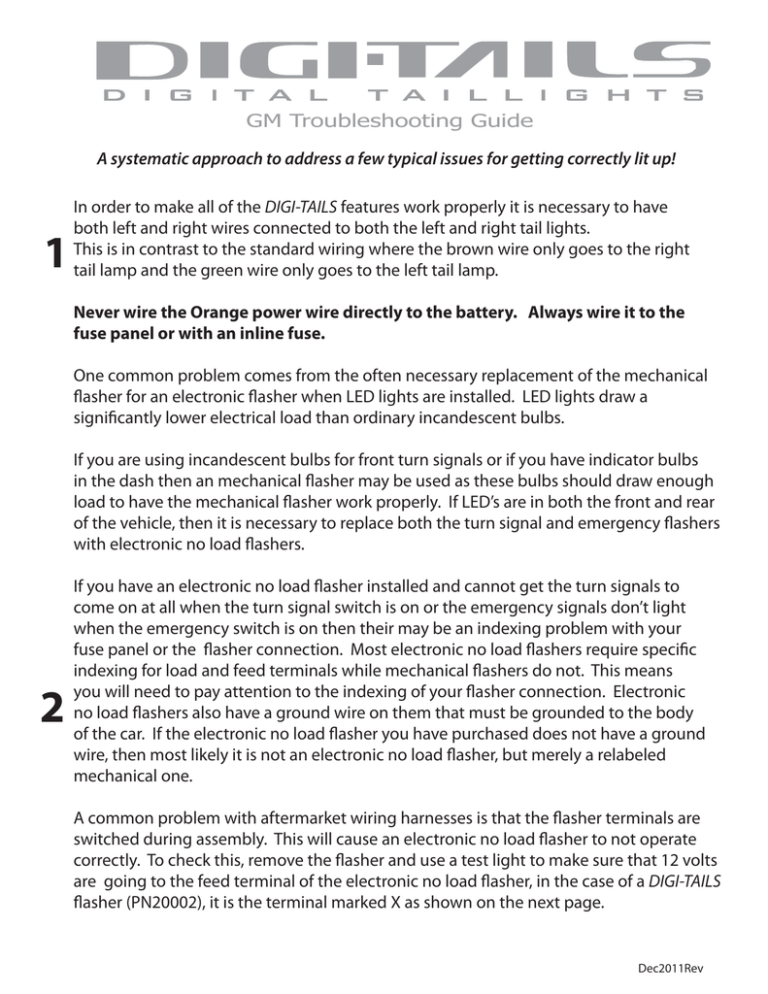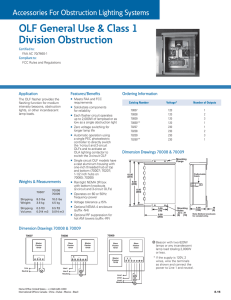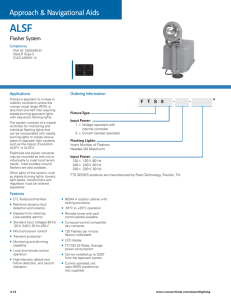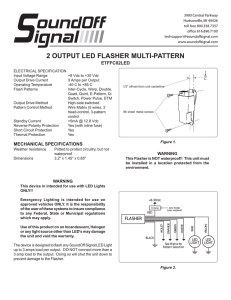Troubleshooting GM - DIGI
advertisement

GM Troubleshooting Guide A systematic approach to address a few typical issues for getting correctly lit up! 1 In order to make all of the DIGI-TAILS features work properly it is necessary to have both left and right wires connected to both the left and right tail lights. This is in contrast to the standard wiring where the brown wire only goes to the right tail lamp and the green wire only goes to the left tail lamp. Never wire the Orange power wire directly to the battery. Always wire it to the fuse panel or with an inline fuse. One common problem comes from the often necessary replacement of the mechanical flasher for an electronic flasher when LED lights are installed. LED lights draw a significantly lower electrical load than ordinary incandescent bulbs. If you are using incandescent bulbs for front turn signals or if you have indicator bulbs in the dash then an mechanical flasher may be used as these bulbs should draw enough load to have the mechanical flasher work properly. If LED’s are in both the front and rear of the vehicle, then it is necessary to replace both the turn signal and emergency flashers with electronic no load flashers. 2 If you have an electronic no load flasher installed and cannot get the turn signals to come on at all when the turn signal switch is on or the emergency signals don’t light when the emergency switch is on then their may be an indexing problem with your fuse panel or the flasher connection. Most electronic no load flashers require specific indexing for load and feed terminals while mechanical flashers do not. This means you will need to pay attention to the indexing of your flasher connection. Electronic no load flashers also have a ground wire on them that must be grounded to the body of the car. If the electronic no load flasher you have purchased does not have a ground wire, then most likely it is not an electronic no load flasher, but merely a relabeled mechanical one. A common problem with aftermarket wiring harnesses is that the flasher terminals are switched during assembly. This will cause an electronic no load flasher to not operate correctly. To check this, remove the flasher and use a test light to make sure that 12 volts are going to the feed terminal of the electronic no load flasher, in the case of a DIGI-TAILS flasher (PN20002), it is the terminal marked X as shown on the next page. Dec2011Rev Typical Flasher and Light Layout. ( GM colors shown) Passenger Side Front Driver Side Front Turn Signal Switch 12 volt power source goes to X Turn signal Flasher X Turn Signal load goes to L L Fuse Panel Emergency Flasher X L Black wire must be grounded Driver Side Rear Passenger Side Rear Refer to the DIGI-TAILS wiring schematic for wiring the DIGI-TAILS LED panels. Dec2011Rev Problems Possible Causes Solutions Brake lights come on when turn signal is applied. Yellow and green wires are wired together. (signal wires) Keep all same signals and colors together. (see item 1) Functions seem reversed or scrambled. Incorrect signal connections. (yellow to brown, brown to green, etc.) Keep all same signals and colors together. (see item 1) Only running lights turn on. Orange wires are not connected. Connect orange wire to constant fused 12 volt source. Turn signals will not flash. Not enough load to trigger the flasher. Vehicle wiring is incorrectly indexed. See item 2. Emergency signals will not flash. Not enough load to trigger the flasher. Vehicle wiring is incorrectly indexed See item 2. Strange flicker or random functions. Bad or loose ground. All grounds are to be clean and attached to a part of the car that is not insulated from the battery’s negative side. Orange wire is connected to a signal wire or power source may have electrical noise. Orange wire is to be connected to a constant fused 12 volt source. Dec20011Rev




